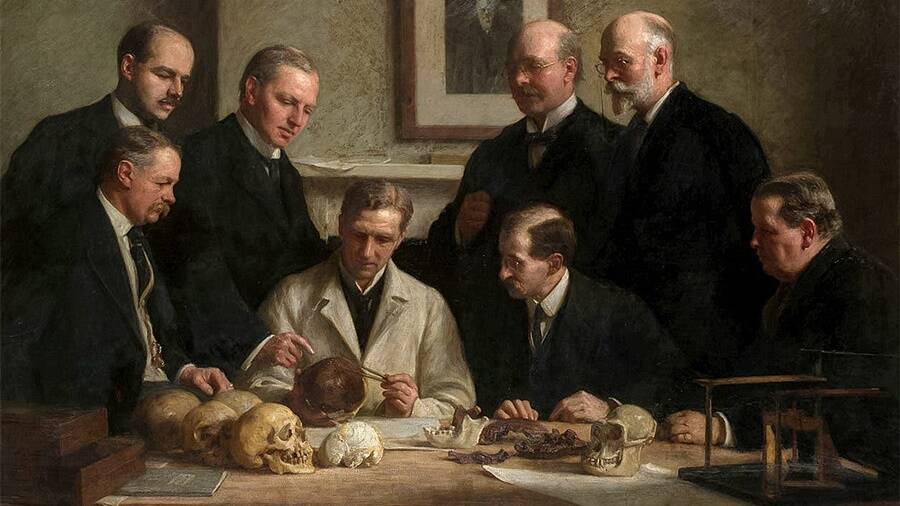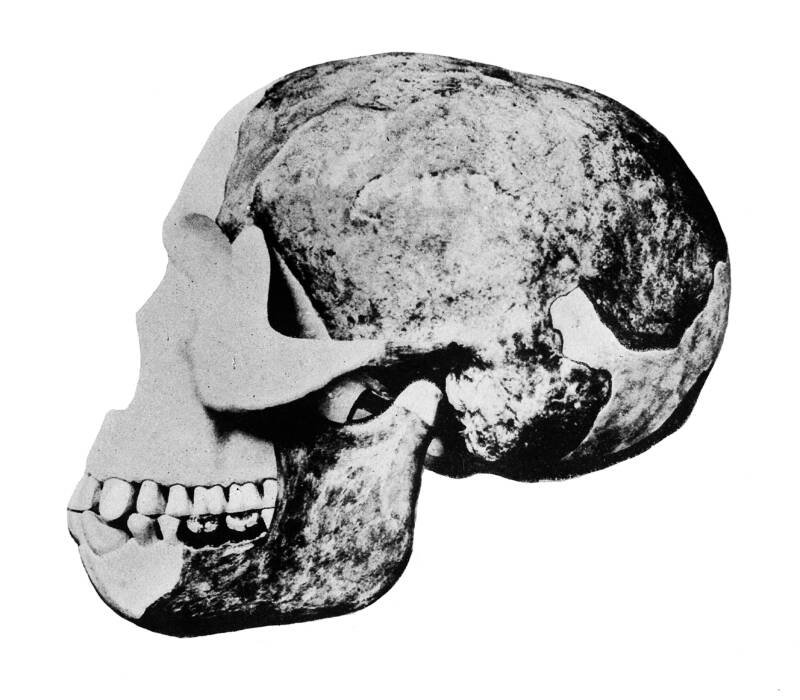Charles Dawson, The Famous Conman Of Archaeology

John Cooke/Wikimedia CommonsScientists examine the so-called Piltdown Man, a specimen that archaeologist and brilliant conman Charles Dawson — in the upper right — claimed to have discovered.
In 1912, archaeologists of the world were stunned by a remarkable discovery: the skull of a humanoid being that exhibited primate traits. The specimen was dubbed the Piltdown Man, a reference to the area in Sussex, England, where it was allegedly first discovered by an amateur fossil hunter and lawyer named Charles Dawson.
Even though the bones would eventually prove to be fake, at the time, it wasn’t difficult for Charles Dawson to get away with his scam. Like many con artists, he was already a well-respected figure in the archaeological community.
At 21, he impressed England’s high society after being elected a fellow of the Geological Society, and in 1895, Dawson was elected a fellow of the Society of Antiquaries in London.
The skull he found rocked the world of science and was considered by many to be the possible “missing link” between humans and apes. But the truth was much simpler: the specimen was a forgery by Dawson, who was nothing more than an archaeological con artist.
It’s said that the specimen first came to light after Dawson wrote his friend, paleontologist Sir Arthur Smith Woodward at the Natural History Museum, that he had uncovered a “thick portion of a human (?) skull which will rival H. heidelbergensis in solidity” near a village in Sussex.

Wellcome ImagesThe skull of the Piltdown Man, as “found” by conman Dawson.
Woodward and Dawson carried out excavations at the site and allegedly found several other artifacts, including an apelike mandible, molar teeth, stone tools, fossilized animals, a humanlike skull, and canine teeth that were somewhere between a human’s and an ape’s.
They presented their findings to the Geological Society of London in 1912, and they claimed that the specimen was possibly a “missing link” that dated back to about 500,000 years ago. It was named Eoanthropus dawsoni, otherwise known as Piltdown Man. Many scientists in the field were immediately taken by the finding, but there were a few who doubted its authenticity.
In fact, the scientific community argued about the Piltdown Man’s true origins even 100 years after Dawson’s death. Then, in 1953, the conman’s elaborate scheme was confirmed when scientists at the University of Oxford used the then-new technique of fluorine dating to examine the fossils from Piltdown.
They found that the famous Piltdown Man’s bones were not all the same age and that they were a combination of carved out and stained bones derived from a human specimen and an ape.
Even though Piltdown Man was Dawson’s most famous archaeological scam, it was hardly the con artist’s only one. Later, it was uncovered that Dawson was quite the small-time forger, privately selling off supposedly rare artifacts he had found to rich bidders — artifacts which all turned out to be fakes.
According to the BBC, out of the conman’s numerous “discoveries” at least 38 were fake. These included the teeth of a creature he dubbed P. dawsoni, a “Roman” statuette, and the so-called Brighton “Toad in the Hole.”
The archaeological conman’s schemes have become a cautionary tale in the world of archaeology. As paleontologist Isabelle De Groote, who performed her own analysis of the Piltdown Man in 2009, put it, “Piltdown Man sets a good example of the need for us to take a step back and look at the evidence for what it is and not for whether it conforms to our preconceived ideas.”





